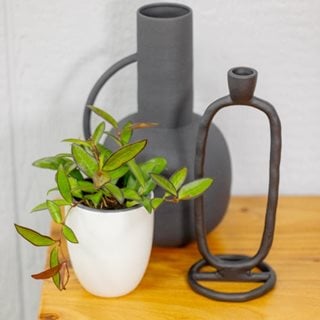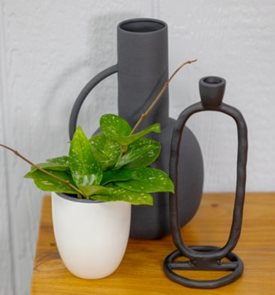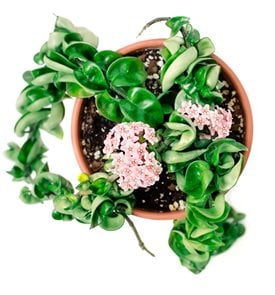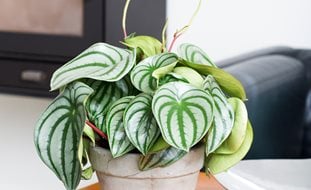A Guide to Growing Hoya Plant
Get planting and care tips for growing this easy-care flowering houseplant.
Endless Cascades™ Teacup Anemone™ wax vine. Photo by: Proven Winners
Not many houseplants give you both attractive foliage and fragrant flowers, which is why the hoya plant has become a favorite of many indoor gardeners. Often called wax plant because of its thick, waxy leaves, this trailing tropical vine looks just as beautiful cascading from a container as it does climbing a trellis or other vertical support.
Although hoyas are commonly grown for their gorgeous foliage—which comes in a wide range of colors and forms—it’s a real treat when they decide to bloom and flaunt their showy clusters of perfect porcelain-like flowers. And when given the proper care, many hoyas are exceptionally long-lived and can become lasting additions to your indoor plant collection.
On this page: Basics | Growing Tips | Care | Varieties | Common Problems | FAQs
On this page:
- HOYA PLANT BASICS
- GROWING HOYA PLANTS
- HOYA PLANT CARE
- HOYA PLANT VARIETIES
- FREQUENTLY ASKED QUESTIONS
BASICS
Botanical name:
Hoya spp. and hybrids
Common names:
Hoya, wax plant, wax vine, porcelain flower, honey plant, Hindu rope plant
Origin:
Native to eastern Asia and Australia
Care level:
Easy
Growth rate:
Slow
Light requirements:
Bright, indirect light
Size:
Can trail or climb up to 4 feet or more
Foliage:
Semi-succulent leaves may be lancelate, almond-shaped or heart-shaped, in colors ranging from medium green to multicolored flecked or variegated patterns.
Flowers:
Produces rounded clusters of tiny star-shaped flowers with white, pink or red petals and rosy pink to maroon centers. Each cluster may include as many as 30 blooms. Depending on the variety, the scent can range from citrusy to intensely sweet, and some even smell like chocolate!
Special attributes:
- Has low water needs
- Purifies the air by filtering out impurities
- Does not need frequent repotting or pruning
- Non-toxic to people and pets
GROWING HOYA PLANTS
Where to grow:
Most Hoya prefer the bright, indirect sunlight of a south-, west- or east-facing window. Some direct early morning or late afternoon sun is okay, and may help to promote flowering. But avoid too much sun, which can scorch or discolor the leaves.
Temperature and humidity:
Hoya thrive in a warm and humid environment, like they are accustomed to in their native tropical habitat, with temperatures ranging from 60° to 85° F and humidity levels of 40% or higher. You can help boost the humidity by using a humidifier, misting the leaves, or keeping your plant on a pebble tray. Avoid exposing your hoya to extreme temperature fluctuations or cold drafts, which can stress the plant and cause the leaves to drop. See more houseplants that thrive in humidity.
Soil type:
Use a well-draining potting mix amended with perlite and orchid bark, or buy a preblended hoya potting mix. Because hoyas are epiphytes (plants that attach themselves to another plant for support), they feed off of nutrients in the air, so a light and airy mix is essential.
Pot requirements:
Always grow your hoya in a pot with holes at the bottom for good drainage, since the roots are very sensitive to overly wet soil. For better air flow, consider putting your plant in an unglazed porous container made of clay or terracotta.

Endless Cascades™ Adrift™ hoya. Photo by: Proven Winners
HOYA PLANT CARE
Watering:
Because hoyas are semi-succulent and store water in their leaves, they don’t need frequent watering and can tolerate a bit of neglect. Generally, you only need to water them every 10 to 14 days, or whenever the top few inches of soil feel dry. In the winter, when your plant isn’t actively growing, you can water more sparingly.
At every watering, thoroughly soak the soil and allow the excess water to drain out completely. The worst mistake you can make is to overwater, which can result in root rot and yellowing of the foliage.
Fertilizing:
Fertilize your hoya monthly when it is actively growing or flowering using a general-purpose houseplant fertilizer diluted to half strength or a light application of worm compost. Stop fertilizing during the winter months, when plant growth slows.
Pruning:
Hoya tend to be slow growers, but occasionally they may need light a pruning to control their size and prevent them from getting leggy. Cut the vines just above a leaf node, being careful not to snip off the short stalks, or spurs, where the flowers emerge. Blooms grow from the same spurs year after year, so removing them will delay the development of new flowers.
Propagation:
From stem cuttings, rooted in soil or water. (*See note below on propagating patented plants—check your plant tags for ® or ™ symbols next to the plant name).
Repotting:
Hoyas don’t mind being potbound and will actually bloom more prolifically if they are snug in their quarters. Typically, you can wait 3 years or longer before moving a hoya to a new container, but you can repot sooner if you see roots poking through the pot’s drainage holes. Choose a new container no more than 2 inches wider in diameter than the current one, and fill it with fresh potting mix before transplanting.
Pests and diseases:
Keep an eye out for common houseplant pests, especially mealybugs and spider mites. Hoyas are also prone to root rot, especially if overwatered.
HOYA PLANT VARIETIES
FREQUENTLY ASKED QUESTIONS
How do I encourage hoyas to flower?
Under ideal conditions, Hoya will bloom every spring and summer, although it may take 2 to 3 years for some hoyas to reach maturity and produce flowers. If your hoya isn’t blooming, move your plant to a location where it receives several hours of direct morning or late afternoon sunlight daily. If you can’t provide enough natural light, try supplementing with a full-spectrum LED grow light. Keeping your plant tightly root-bound can also stimulate blooming, so don’t repot too often.
Can I grow hoyas outdoors?
If you live in zones 10-12, where hoyas are evergreen perennials, you can grow them outdoors year-round, as long as the temperatures don’t drop below 50° F. In colder climates, it’s fine to move your hoya plant outdoors for the summer months once nighttime temperatures warm to the 60s or above, bringing it back indoors when the temperatures drop in the fall. When growing a hoya outdoors, place it in a partially shaded location. Exposure to too much direct sunlight, especially during the hottest parts of the day, can burn the foliage.
Do hoyas prefer to climb or hang?
They are happy either way, so the choice is yours. You can train your plants to twine around a vertical support, such as a trellis or moss pole, or drape them from a hanging basket or other container. Although most hoya vines will get quite long, you can double them back if you want to give your plant a denser appearance.
How long does a hoya plant live?
Hoyas have an impressive lifespan compared to other houseplants, living 30 years or longer under optimal conditions. If you give your hoya everything it needs to thrive, this resilient houseplant will grace you with its beauty for a long time to come.
*REGARDING PROPAGATION: When it comes to propagating patented plants, there are strict rules in place prohibiting reproduction or propagation of these plants in any way. This means you can't reproduce them (even for use in your own garden), sell them, or bring them into the country without permission. The law does not make exceptions for what some might consider minor infringements. Any unauthorized use of patented plants is considered an infringement.












